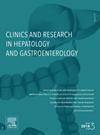Understanding the learning curve of intestinal ultrasound in inflammatory bowel disease: A comparative study between novice, regular and expert
IF 2.6
4区 医学
Q2 GASTROENTEROLOGY & HEPATOLOGY
Clinics and research in hepatology and gastroenterology
Pub Date : 2025-02-09
DOI:10.1016/j.clinre.2025.102548
引用次数: 0
Abstract
Background
Intestinal ultrasound (IUS) has emerged as a valuable tool for monitoring inflammatory bowel disease (IBD), but its reliability depends on the technical skills of the operator.
Aims
This study aimed to assess the IUS learning curve of a novice briefly trained to get him familiarized with the ultrasound machine and normal/abnormal IUS images, and a gastroenterologist with formal general ultrasound training and regular IUS experience (> 200 exams), using an expert radiologist as the gold standard.
Methods
The ULTRA-IBD study was a single-center, prospective study involving 50 consecutive IBD patients. Three successive IUS examinations were performed on each patient by the 3 operators. Inter-rater agreement on IUS disease activity was calculated using the intraclass correlation coefficient.
Results
The experienced gastroenterologist demonstrated consistently good agreement with the radiologist throughout the study, while the novice failed to go beyond poor agreement after 50 examinations, although a faster learning curve was observed in patients without history of IBD surgery.
Conclusion
These findings highlight the difficulty of the technical performance of IUS rather than its interpretation. Comprehensive ultrasound training beforehand and between 50 and 200 examinations of experience are necessary before embarking on IUS.
了解肠道超声在炎性肠病中的学习曲线:新手、常规和专家的比较研究
肠道超声(IUS)已成为监测炎症性肠病(IBD)的一种有价值的工具,但其可靠性取决于操作者的技术技能。本研究以放射科专家为金标准,评估经过简单培训以熟悉超声机器和正常/异常IUS图像的新手和经过正规常规超声培训并有常规IUS经验(>; 200次考试)的胃肠病学家的IUS学习曲线。方法超IBD研究为单中心前瞻性研究,纳入50例连续IBD患者。3名操作人员对每位患者连续进行3次IUS检查。使用类内相关系数计算IUS疾病活动性的等级间一致性。结果在整个研究过程中,经验丰富的胃肠病学家与放射科医生表现出一致的良好一致性,而新手在50次检查后未能超越差的一致性,尽管在没有IBD手术史的患者中观察到更快的学习曲线。结论这些发现突出了IUS技术性能的难度,而不是其解释。在开始IUS之前,全面的超声培训和50至200次经验考试是必要的。
本文章由计算机程序翻译,如有差异,请以英文原文为准。
求助全文
约1分钟内获得全文
求助全文
来源期刊

Clinics and research in hepatology and gastroenterology
GASTROENTEROLOGY & HEPATOLOGY-
CiteScore
4.30
自引率
3.70%
发文量
198
审稿时长
42 days
期刊介绍:
Clinics and Research in Hepatology and Gastroenterology publishes high-quality original research papers in the field of hepatology and gastroenterology. The editors put the accent on rapid communication of new research and clinical developments and so called "hot topic" issues. Following a clear Editorial line, besides original articles and case reports, each issue features editorials, commentaries and reviews. The journal encourages research and discussion between all those involved in the specialty on an international level. All articles are peer reviewed by international experts, the articles in press are online and indexed in the international databases (Current Contents, Pubmed, Scopus, Science Direct).
Clinics and Research in Hepatology and Gastroenterology is a subscription journal (with optional open access), which allows you to publish your research without any cost to you (unless you proactively chose the open access option). Your article will be available to all researchers around the globe whose institution has a subscription to the journal.
 求助内容:
求助内容: 应助结果提醒方式:
应助结果提醒方式:


